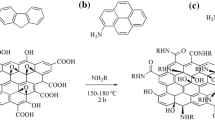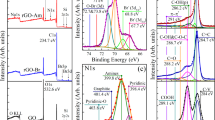Abstract
A method for carboxylation of graphene oxide (GO) with chloroacetic acid that precisely optimizes and controls the efficacy of the process for bioconjugation applications is proposed. Quantification of COOH groups on nano-graphene oxide sheets (NGOS) is performed by novel colorimetric methylene blue (MB) assay. The GO is synthesized and carboxylated by chloroacetic acid treatment under strong basic condition. The size and morphology of the as-prepared NGOS are characterized by scanning electron microscopy, transmission electron microscopy (TEM), and atomic force microscopy (AFM). The effect of acid to base molar ratio on the physical, chemical, and morphological properties of NGOS is analyzed by Fourier-transformed infrared spectrometry (FTIR), UV–Vis spectroscopy, X-ray diffraction (XRD), AFM, and zeta potential. For evaluation of bioconjugation efficacy, the synthesized nano-carriers with different carboxylation ratios are functionalized by octaarginine peptide sequence (R8) as a biomolecule model containing amine groups. The quantification of attached R8 peptides to graphene nano-sheets’ surface is performed with a colorimetric-based assay which includes the application of 2,4,6-Trinitrobenzene sulfonic acid (TNBS). The results show that the thickness and lateral size of nano-sheets are dramatically decreased to 0.8 nm and 50–100 nm after carboxylation process, respectively. X-ray analysis shows the nano-sheets interlaying space is affected by the alteration of chloroacetic acid to base ratio. The MB assay reveals that the COOH groups on the surface of NGOS are maximized at the acid to base ratio of 2 which is confirmed by FTIR, XRD, and zeta potential. The TNBS assay also shows that bioconjugation of the optimized carboxylated NGOS sample with octaarginine peptide is 2.5 times more efficient compared to bare NGOS. The present work provides evidence that treatment of GO by chloroacetic acid under an optimized condition would create a functionalized high surface area nano-substrate which can be used for subsequent efficient bioconjugation applications.
Graphical Abstract









Similar content being viewed by others
References
Akbari M, Tamayol A, Laforte V, Annabi N, Najafabadi AH, Khademhosseini A, Juncker D (2014) Composite living fibers for creating tissue constructs using textile techniques. Adv Funct Mater 24:4060–4067
Bagri A, Mattevi C, Acik M, Chabal YJ, Chhowalla M, Shenoy VB (2010) Structural evolution during the reduction of chemically derived graphene oxide. Nat Chem 2:581–587
Bao H et al (2011) Chitosan-functionalized graphene oxide as a nanocarrier for drug and gene delivery. Small 7:1569–1578
Cha C, Shin SR, Annabi N, Dokmeci MR, Khademhosseini A (2013) Carbon-based nanomaterials: multifunctional materials for biomedical engineering. ACS Nano 7:2891–2897
Chang Y et al (2011) In vitro toxicity evaluation of graphene oxide on A549 cells. Toxicol Lett 200:201–210
Chowdhury I, Duch MC, Mansukhani ND, Hersam MC, Bouchard D (2013) Colloidal properties and stability of graphene oxide nanomaterials in the aquatic environment. Environ Sci Technol 47:6288–6296
Chung C, Kim YK, Shin D, Ryoo SR, Hong BH, Min DH (2013) Biomedical applications of graphene and graphene oxide. Acc Chem Res 46:2211–2224
Das S, Mitra S, Khurana SP, Debnath N (2014) Nanomaterials for biomedical applications. Frontiers in Life Science:1–9
Davis W, Erickson C, Johnston C, Delfino J, Porter J (1999) Quantitative Fourier transform infrared spectroscopic investigation humic substance functional group composition. Chemosphere 38:2913–2928
Dong H et al (2010) Poly (ethylene glycol) conjugated nano-graphene oxide for photodynamic therapy. Sci China Chem 53:2265–2271
Dreyer DR, Park S, Bielawski CW, Ruoff RS (2010) The chemistry of graphene oxide. Chem Soc Rev 39:228–240
Ganguly A, Sharma S, Papakonstantinou P, Hamilton J (2011) Probing the thermal deoxygenation of graphene oxide using high-resolution in situ X-ray-based spectroscopies. J Phys Chem C 115:17009–17019
Gao W, Alemany LB, Ci L, Ajayan PM (2009) New insights into the structure and reduction of graphite oxide. Nat Chem 1:403–408
Goenka S, Sant V, Sant S (2014) Graphene-based nanomaterials for drug delivery and tissue engineering. J Control Release 173:75–88
Huang P et al (2010) Folic acid-conjugated graphene oxide loaded with photosensitizers for targeting photodynamic therapy. Theranostics 1:240–250
Hummers W, Offeman R (1958) Graphite oxide (GO) was prepared using the well-known Hummers method described by Hummers. J Am Chem Soc 80:1339–1345
Jin L et al (2012) Functionalized graphene oxide in enzyme engineering: A selective modulator for enzyme activity and thermostability. ACS Nano 6:4864–4875
Karthika P, Rajalakshmi N, Dhathathreyan KS (2012) Functionalized exfoliated graphene oxide as supercapacitor electrodes. Soft Nanosci Lett 2:59
Khazraie Shoulaifar T, DeMartini N, Ivaska A, Fardim P, Hupa M (2012) Measuring the concentration of carboxylic acid groups in torrefied spruce wood. Bioresour Technol 123:338–343
Kim H, Namgung R, Singha K, Oh I-K, Kim WJ (2011) Graphene oxide–polyethylenimine nanoconstruct as a gene delivery vector and bioimaging tool. Bioconj Chem 22:2558–2567
Lee V, Dennis RV, Schultz BJ, Jaye C, Fischer DA, Banerjee S (2012) Soft x-ray absorption spectroscopy studies of the electronic structure recovery of graphene oxide upon chemical defunctionalization. J Phys Chem C 116:20591–20599
Li Q, Fan F, Wang Y, Feng W, Ji P (2013) Enzyme immobilization on carboxyl-functionalized graphene oxide for catalysis in organic solvent. Ind Eng Chem Res 52:6343–6348
Liu Z, Robinson JT, Sun X, Dai H (2008) PEGylated nanographene oxide for delivery of water-insoluble cancer drugs. J Am Chem Soc 130:10876–10877
Liu Y, Deng R, Wang Z, Liu H (2012) Carboxyl-functionalized graphene oxide–polyaniline composite as a promising supercapacitor material. J Mater Chem 22:13619–13624
Mao HY, Laurent S, Chen W, Akhavan O, Imani M, Ashkarran AA, Mahmoudi M (2013) Graphene: promises, facts, opportunities, and challenges in nanomedicine. Chem Rev 113:3407–3424
Mu Q et al (2012) Size-dependent cell uptake of protein-coated graphene oxide nanosheets. ACS Appl Mater Interfaces 4:2259–2266
Najafabadi AH et al (2014) Biodegradable nanofibrous polymeric substrates for generating elastic and flexible electronics. Adv Mater 26:5823–5830
Nguyen KC (2012) Quantitative analysis of COOH-terminated alkanethiol SAMs on gold nanoparticle surfaces. Adv Nat Sci Nanosci Nanotechnol 3:045008
Pinto AM, Gonçalves IC, Magalhães FD (2013) Graphene-based materials biocompatibility: a review. Colloids Surf B Biointerfaces 111:188–202. doi:10.1016/j.colsurfb.2013.05.022
Šauperl O, Stana-Kleinschek K, Vončina B, Sfiligoj-Smole M, Marechal M-L (2003) Application of spectrophotometric methods in assessing the influence of alkaline treatment on the degree of crosslinking of cotton cellulose with BTCA. Croat Chem Acta 76:293–298
Shen J, Shi M, Yan B, Ma H, Li N, Hu Y, Ye M (2010) Covalent attaching protein to graphene oxide via diimide-activated amidation. Colloids Surf B 81:434–438
Shen H, Zhang L, Liu M, Zhang Z (2012) Biomedical applications of graphene. Theranostics 2:283
Shiroh F (2002) Arginine-rich peptides: potential for intracellular delivery of macromolecules and the mystery of the translocation mechanisms. Int J Pharm 245:1–7. doi:10.1016/s0378-5173(02)00337-x
Sun Z (2012) Graphene chemistry: synthesis and modulation. Rice University
Sun X, Liu Z, Welsher K, Robinson JT, Goodwin A, Zaric S, Dai H (2008) Nano-graphene oxide for cellular imaging and drug delivery. Nano Res 1:203–212
Szabó T, Berkesi O, Forgó P, Josepovits K, Sanakis Y, Petridis D, Dékány I (2006a) Evolution of surface functional groups in a series of progressively oxidized graphite oxides. Chem Mater 18:2740–2749
Szabó T, Tombácz E, Illés E, Dékány I (2006b) Enhanced acidity and pH-dependent surface charge characterization of successively oxidized graphite oxides. Carbon 44:537–545
Tang Z, He S, Pei H, Du D, Fan C, Lin Y (2013) Graphene-based optical biosensors and imaging biosensors based on nanomaterials and nanodevices:93
Wang H, Zhang Q, Chu X, Chen T, Ge J, Yu R (2011a) Graphene oxide-peptide conjugate as an intracellular protease sensor for caspase-3 activation imaging in live cells. Angew Chem Int Ed 50:7065–7069
Wang Y, Li Z, Wang J, Li J, Lin Y (2011b) Graphene and graphene oxide: biofunctionalization and applications in biotechnology. Trends Biotechnol 29:205–212
Wen H et al (2012) Engineered redox-responsive PEG detachment mechanism in PEGylated nano-graphene oxide for intracellular drug delivery. Small 8:760–769
Yang Q, Pan X, Clarke K, Li K (2011) Covalent functionalization of graphene with polysaccharides. Ind Eng Chem Res 51:310–317
Yang K, Feng L, Hong H, Cai W, Liu Z (2013a) Preparation and functionalization of graphene nanocomposites for biomedical applications. Nat Protoc 8:2392–2403
Yang K, Feng L, Shi X, Liu Z (2013b) Nano-graphene in biomedicine: theranostic applications. Chem Soc Rev 42:530–547
Yue Z, Lv P, Yue H, Gao Y, Ma D, Wei W, Ma G (2013) Inducible graphene oxide probe for high-specific tumor diagnosis. Chem Commun 49:3902–3904
Yuge R, Zhang M, Tomonari M, Yoshitake T, Iijima S, Yudasaka M (2008) Site identification of carboxyl groups on graphene edges with Pt derivatives. ACS Nano 2:1865–1870
Yukawa H et al (2010) Quantum dots labeling using octa-arginine peptides for imaging of adipose tissue-derived stem cells. Biomaterials 31:4094–4103
Zhang L, Liang J, Huang Y, Ma Y, Wang Y, Chen Y (2009) Size-controlled synthesis of graphene oxide sheets on a large scale using chemical exfoliation. Carbon 47:3365–3368
Zhang L, Lu Z, Zhao Q, Huang J, Shen H, Zhang Z (2011) Enhanced chemotherapy efficacy by sequential delivery of siRNA and anticancer drugs using PEI-grafted graphene oxide. Small 7:460–464
Zhang Y, Nayak TR, Hong H, Cai W (2012) Graphene: a versatile nanoplatform for biomedical applications. Nanoscale 4:3833–3842
Zhang K, Heo N, Shi X, Park JH (2013) Chemically modified graphene oxide-wrapped quasi-micro Ag decorated silver trimolybdate nanowires for photocatalytic applications. J Phys Chem C 117:24023–24032
Zhang J, Sun Y, Wu Q, Gao Y, Zhang H, Bai Y, Song D (2014) Preparation of graphene oxide-based surface plasmon resonance biosensor with Au bipyramid nanoparticles as sensitivity enhancer. Colloids Surf B Biointerfaces 116:211–218. doi:10.1016/j.colsurfb.2014.01.003
Acknowledgments
The authors wish to thank financial supports provided for this work by the National Institute of Genetic Engineering and Biotechnology (NIGEB). We also gratefully acknowledge the scientific help and assistance of Mohammad Hasan Mohammadzadeh and Mahdi Amrollahi.
Author information
Authors and Affiliations
Corresponding authors
Rights and permissions
About this article
Cite this article
Imani, R., Emami, S.H. & Faghihi, S. Nano-graphene oxide carboxylation for efficient bioconjugation applications: a quantitative optimization approach. J Nanopart Res 17, 88 (2015). https://doi.org/10.1007/s11051-015-2888-6
Received:
Accepted:
Published:
DOI: https://doi.org/10.1007/s11051-015-2888-6




